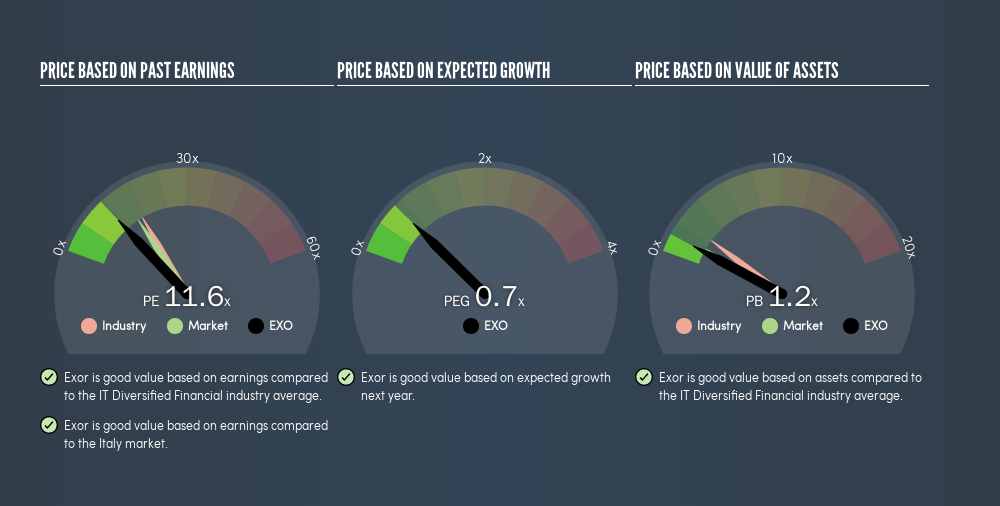This article is written for those who want to get better at using price to earnings ratios (P/E ratios). We'll show how you can use Exor N.V.'s (BIT:EXO) P/E ratio to inform your assessment of the investment opportunity. Exor has a P/E ratio of 11.6, based on the last twelve months. That is equivalent to an earnings yield of about 8.6%.
Check out our latest analysis for Exor
How Do You Calculate Exor's P/E Ratio?
The formula for price to earnings is:
Price to Earnings Ratio = Price per Share ÷ Earnings per Share (EPS)
Or for Exor:
P/E of 11.6 = €62.34 ÷ €5.37 (Based on the trailing twelve months to December 2018.)
Is A High P/E Ratio Good?
The higher the P/E ratio, the higher the price tag of a business, relative to its trailing earnings. That isn't necessarily good or bad, but a high P/E implies relatively high expectations of what a company can achieve in the future.
How Does Exor's P/E Ratio Compare To Its Peers?
The P/E ratio essentially measures market expectations of a company. We can see in the image below that the average P/E (17) for companies in the diversified financial industry is higher than Exor's P/E.

This suggests that market participants think Exor will underperform other companies in its industry.
How Growth Rates Impact P/E Ratios
Generally speaking the rate of earnings growth has a profound impact on a company's P/E multiple. Earnings growth means that in the future the 'E' will be higher. Therefore, even if you pay a high multiple of earnings now, that multiple will become lower in the future. A lower P/E should indicate the stock is cheap relative to others -- and that may attract buyers.
Exor's earnings per share fell by 5.2% in the last twelve months. But over the longer term (3 years), earnings per share have increased by 76%. And it has shrunk its earnings per share by 10% per year over the last five years. So we might expect a relatively low P/E.
Remember: P/E Ratios Don't Consider The Balance Sheet
One drawback of using a P/E ratio is that it considers market capitalization, but not the balance sheet. So it won't reflect the advantage of cash, or disadvantage of debt. Theoretically, a business can improve its earnings (and produce a lower P/E in the future) by investing in growth. That means taking on debt (or spending its cash).
While growth expenditure doesn't always pay off, the point is that it is a good option to have; but one that the P/E ratio ignores.
How Does Exor's Debt Impact Its P/E Ratio?
Exor has net debt worth a very significant 185% of its market capitalization. This is a relatively high level of debt, so the stock probably deserves a relatively low P/E ratio. Keep that in mind when comparing it to other companies.
The Verdict On Exor's P/E Ratio
Exor has a P/E of 11.6. That's below the average in the IT market, which is 15.7. Given meaningful debt, and a lack of recent growth, the market looks to be extrapolating this recent performance; reflecting low expectations for the future.
When the market is wrong about a stock, it gives savvy investors an opportunity. As value investor Benjamin Graham famously said, 'In the short run, the market is a voting machine but in the long run, it is a weighing machine.' So this free visual report on analyst forecasts could hold the key to an excellent investment decision.
You might be able to find a better buy than Exor. If you want a selection of possible winners, check out this free list of interesting companies that trade on a P/E below 20 (but have proven they can grow earnings).
We aim to bring you long-term focused research analysis driven by fundamental data. Note that our analysis may not factor in the latest price-sensitive company announcements or qualitative material.
If you spot an error that warrants correction, please contact the editor at editorial-team@simplywallst.com. This article by Simply Wall St is general in nature. It does not constitute a recommendation to buy or sell any stock, and does not take account of your objectives, or your financial situation. Simply Wall St has no position in the stocks mentioned. Thank you for reading.
About BIT:EXO
Exor
Engages in the automotive, agriculture and construction, sports car, commercial vehicle, and powertrain businesses worldwide.
Undervalued with adequate balance sheet.
Similar Companies
Market Insights
Community Narratives



